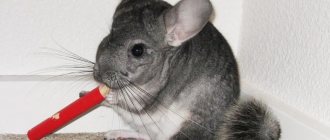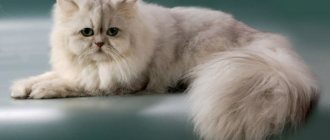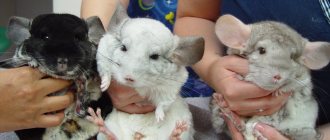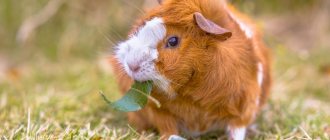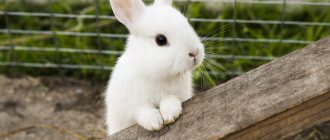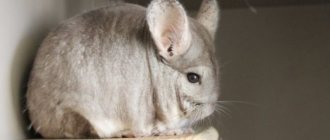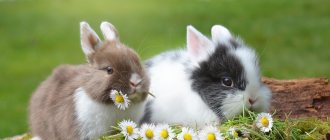- home
- Guinea pig
- Choosing and purchasing a guinea pig
02/18/2019 When choosing a pet, you must not forget that you will have to take care of it for many years, this is not a temporary hobby. Many people have cats and dogs at home. But some need to be walked regularly, while others leave fur everywhere. In recent years, rodents have become popular as pets. They are easy to care for, no hair remains, and they don’t need to be taken outside. Often you have to choose between a chinchilla and a guinea pig. Both of these animals have their own nuances in care, advantages and disadvantages.
Features of chinchillas
Chinchillas are medium-sized rodents with beautiful thick fur and a bushy tail.
The color of the coat is gray with a white belly. They also come in black, snow white, white and pink and beige. The maximum weight of an adult chinchilla is 800-900 g, and the height of the animal can reach 30-38 cm. The tail length is 12-17 cm.
Chinchillas have large, slightly rounded ears, which can always be used to determine their mood. If he is scared, his ears lie flat on his back and are in the same position when he sleeps. And if the chinchilla listens and shows interest, its ears are raised high.
These exotic rodents have very beautiful shiny black eyes in which you can see your reflection. In addition, chinchillas have strong and massive hind legs, which allows them to easily push off the ground while running. They are longer than the front legs.
Character, behavior and habits of a rodent
Chinchillas are intelligent animals that adapt well to a home environment. They are very curious, show interest in their surroundings and do not neglect any changes in the cage or room.
If there are guests in the house, they react very actively, trying to attract attention to their person. They also make interesting sounds that help you understand how the animal is feeling. For example, if a chinchilla is unhappy with something, it makes a cracking sound.
Other features of chinchilla behavior, habits and character:
- They are very energetic and may jump around a lot in the cage, demanding to be released;
- nocturnal, sleep most of the day;
- They quickly become attached to their owners, but do not like to be petted and prefer to be watched from the side;
- they tolerate loneliness very well.
A characteristic feature of chinchillas is also their cleanliness. They always keep their fur clean and never stink. The owner should encourage the animal to do this habit and clean the cage regularly.
How to tame a young animal?
The small chinchilla is quite timid, so taming should be gradual and careful so that the animal is not stressed. How to tame a chinchilla at a young age?
It is important to speak kindly to the rodent and often flash before its eyes so that the chinchilla gets used to its owner. But when communicating, you should keep your distance - do not put your face too close to the rodent and do not touch it with your hands. You need to approach your pet at a quiet and slow pace; sudden movements and noise can frighten the chinchilla. At first the animal will behave fearfully
But when he stops hiding, you can try to open the cage door, the movements should be smooth and careful. No taming is complete without treats. Therefore, after 3-4 days, you can give the little chinchilla some tasty treat by opening your palm. After 7 (sometimes 14) days, the chinchilla will take treats from your hands. And only after that you can try to pet her and pick her up. Some owners make a certain sound (for example, clicking) before approaching the cage. After some time, the chinchilla associates this sound with the owner approaching it, which means there will be games or treats ahead.
Where is it better to have a chinchilla in an apartment or in a house?
The home environment is an important factor to consider before adopting a chinchilla. There is no fundamental difference between a private house and an apartment. This type of pet does not need to be walked, so if you can allocate enough space for a cage or display, it will work well.
It is more important to choose a suitable case. Remember that the chinchilla is a nocturnal animal: it sleeps most of the time during the day, but becomes active at dusk. Placing the cage in your bedroom is a bad idea because it will prevent you from sleeping. It will be uncomfortable in the kitchen or living room due to the noise of household appliances and conversations.
Chinchillas are very sensitive to temperature changes. For example, overheating (above 22°C) can lead to heatstroke and death. Therefore, it is important to control the values both in summer (have air conditioning) and in winter (control the heating system).
Residents of apartments in multi-storey buildings should take this into account, since in many buildings housing and communal services are responsible for this, and balancing the numbers using personal equipment can be problematic. To avoid putting your pet in danger, make sure the environment is suitable before purchasing a chinchilla.
Which pet is right for a child?
To understand who is better, a guinea pig or a chinchilla, you need to understand why you are purchasing a pet. If this is the baby’s first animal, then it is better to take a chinchilla, because if you care for it correctly, it will live for many years. This will help save the child from psychological trauma in the event of the death of a pet.
If the child needs someone like a cat who will happily spend time in his arms. It is better to choose a guinea pig that is delighted with communication with the owner.
What does it take to get a chinchilla?
The opinion that keeping a chinchilla requires a lot of money is based precisely on the location of its home.
A chinchilla is less active than a cat or dog.
Such an exotic rodent requires a lot of money. To begin with, you will need to buy the required items such as:
- cage - from 5 thousand rubles;
- house - 500-700 rubles ..;
Don't buy a cage that is too cheap and too small - chinchillas need space. Better to buy a display case. It is much more expensive, from 15 thousand rubles, but it will last longer, and your pet will be more comfortable in it.
Equipped place for chinchillas
- drinking bowls - 200-500 rubles;
- bowl - 100-350 rub.
- swim - 700-1500 rubles;
In addition to startup costs, it's a good idea to take care of monthly supplies. It is important to provide rodents with a nutritious and varied diet whenever possible. And all sorts of wooden accessories will not only provide an interesting variety of leisure time for the animal, but will also help him scrape his teeth:
- Sand (change every 1-3 months) - 200-500 rubles;
- granules (1 kg of main feed) - 400-500 rubles.
- Grain, hay and drying - 300-700 rubles;
- filler (1-5 kg of wood or corn) - 200-400 rubles;
- wood and pumice - from 100 rubles.
Buy only quality food. Chinchillas cannot eat sweets, and most modern companies sell cheap but low-quality food. Sometimes it is safer to buy food from breeders.
Additional but recommended items include a carrier (RUB 800-1,500) that can be used for vet visits and as a waterbed, a hanging hammock for relaxation (RUB 600-00) and a trash can (RUB 200-500).
Prohibited Products
Persimmons are prohibited for feeding. This fruit, useful for humans, is rich in iodine, which is contraindicated for animals. In addition to iodine, persimmons contain a lot of sugar and astringents, which will lead to constipation.
It is not recommended to give chinchillas and beets.
The root vegetable is healthy, but has a laxative effect. In rare cases, small pieces of beets can be given for constipation. Any type of cabbage leads to severe gas formation. Chinchillas love to feast on tea rose petals - they taste pleasant and have an attractive aroma. If flowers are grown in your own garden, there is no danger, but it is better not to give store-bought ones. They contain a lot of pesticides and chemicals that can cause serious poisoning.
When preparing tree branches for the winter, it is worth remembering which species are dangerous and unsuitable for feeding. Branches of which trees cannot be harvested:
- Apricot,
- white acacia,
- Beech,
- Ash leaf maple,
- Common buckthorn
- Cedar,
- Chestnut,
- Branches of any citrus species,
- Cypress,
- Elderberries,
- Cherries,
- Cherries,
- Branches of any coniferous species,
- Holly,
- Hydrangeas,
- Juniper,
- Common maple
- Myrta,
- Oleander,
- Plums.
Branches of stone fruit trees (cherry, cherry, plum, and so on) are dangerous because they contain a dangerous cyanide compound, as a result of the breakdown of which hydrocyanic acid is formed in the chinchilla’s body. If you feed an animal with such twigs, you can get not only severe poisoning, but also the rapid death of your pet.
Prohibited products also include any type of honey, as well as store-bought cottage cheese and fermented milk products.
Not all breeders know that chinchillas should not be given leaves, stems and flowers of indoor plants. Most of them are poisonous to the animal and very often cause death.
It is also not recommended to give any food from a person's table. Everything that is normal and familiar, even useful for people, for a chinchilla becomes the cause of digestive problems, allergies, obesity and other serious diseases. The animal will never refuse tasty and aromatic food and can eat a piece of cake, cheese, meat or fish. However, such food is not normal and familiar to the stomach of a furry pet. And the possible consequences are very sad.
Rules for keeping chinchillas at home
Caring for chinchillas at home does not present any difficulties, but it is necessary to properly equip the cage in which the exotic rodent will live and maintain temperature conditions.
What kind of cage is needed and how to arrange it
The ideal home for your pet chinchilla is a spacious cage measuring 60x50x100 cm. The fluffy rodent loves to jump around the cage, so the higher it is, the more comfortable your pet will feel.
Once you have purchased the right cage for your chinchilla, you need to move on to fitting it correctly.
Necessary equipment:
- Feeder and drinker for food and water. It is recommended to buy metal utensils so that the animal cannot bite them. It is also necessary to firmly secure the feeder, as rodents love to carry them in their teeth.
- Tooth chalk (sold in pet stores).
- Toys - wooden cubes, walnut shells.
- Active rodents will love a running wheel, but a regular one won't work because there is too much space between the bars. An alternative is a metal disk. It has mesh instead of rods. While running, a chinchilla can injure its paw. For such rodents, there are special solid wooden wheels that are safe for active jogging.
- You can also place large unsharpened stones, tree branches and ladders in the cage. On hot days, a chinchilla can cool off on branches. This will help avoid overheating, which is fatal to it. It is very important to choose durable accessories and secure them firmly in the animal’s house so that they do not fall and injure the chinchilla during active movement.
- Among the entertainment complexes in the cages are wooden bridges, tunnels and even hammocks made of thick fabric.
- Chinchillas love sand baths. At least once every 2-3 days, a bowl of clean volcanic sand, selected according to the size of the animal, is placed in the cage. Sand should be purchased at a pet store. Leave the bowl inside the cage for about 30 minutes, after which it is better to remove it, as chinchillas may urinate on the sand. If this happens, the cage will smell bad. Prolonged contact with sand is not recommended, as it dries out the animal's skin.
In pet stores you can buy everything you need to equip a cage for chinchillas. The range includes various toys for curious rodents. Products made from natural wood are considered the safest. Over time, a chinchilla may bite them, but such toys will bring a lot of joyful emotions to the animal and allow it to spend time without the attention of its owner.
Comfortable temperature for a chinchilla
The prerequisite for keeping chinchillas at home is to create a favorable microclimate and maintain optimal air temperature. These animals feel good at a temperature of +12+230C. Direct sunlight should not penetrate the cage, as it is destructive to rodents. The optimal humidity level should not exceed 60%.
Chinchillas do not feel well and become inactive if the air temperature exceeds the maximum recommended value. They feel the same discomfort at low temperatures. The temperature in your chinchilla's home can be monitored using a simple room thermometer and a hygrometer, which determines the level of humidity in the room.
Do chinchillas make noise at night?
It was previously known that chinchillas are active at night. These are the so-called crepuscular animals. When choosing a pet, you should take into account the fact that its activity will increase in the evening. But during the day he will be happy to rest. This happens more often in young animals. Older animals with offspring are calmer.
IMPORTANT: If you try to wake your pet during the day and don't let him sleep, he will become stressed and more likely to get sick. Therefore, you should not forcefully interrupt his rest.
Does the animal have an unpleasant odor?
Almost all pets have some kind of smell that we are not used to. Upon entering any apartment, you can immediately determine by the smell whether someone lives here or not. Perhaps the chinchilla will be an exception. The animal itself does not have an unpleasant odor. Chinchilla is very clean. And if the owner himself cleans the cage on time, changes bedding, and monitors the freshness of food and water, then the problem of unpleasant odors will not bother him. Otherwise, odors will be absorbed by the animal's fur.
Is it possible to be allergic to a pet?
Chinchilla fur causes allergies no more often than any other animal. Therefore, if someone is prone to allergies, the best thing to do is go to the store, hold a few animals in your hands and see how the body reacts.
Maybe having a rodent in the house makes people more sensitive. Before getting rid of your beloved pet, it is better to buy an air purifier and clean your house more often.
Preventive measures can help prevent allergic reactions from occurring:
- When cleaning the cage, it is best to use a protective mask to prevent dust from the fur and filler from entering the body;
- Most often, wipe down the cage and everything in it with a damp cloth or rag.
- it is recommended to replace the store putty with ordinary sawdust;
- bathe the animal in a well-ventilated area.
How dangerous are chinchillas?
May cause allergies.
This may cause skin diseases.
It can carry various infections.
Cage hygiene, hand washing after handling the animal, and more frequent sand baths for pets are essential.
IMPORTANT: Chinchillas very rarely get parasites and do not transmit rabies through bites.
Is it possible for families with children to have a chinchilla?
It is important to understand that every pet is a living creature. Therefore, children should know that pets should be handled with care. These rodents do not like to be squeezed or pressed hard. The chinchilla may get scared or get hurt. He may bite in self-defense.
If the child is very small and, due to his age, is not yet able to understand such things, it is better to avoid contact with the rodent. If a child simply likes to watch animals and will not disturb the pet, then this will not be an obstacle to buying a rodent. Only in such conditions can an animal live happily in a family.
Diseases: how dangerous they are and how to treat them
These animals have strong immunity, which is why, with proper care, they rarely get sick. But being in unfavorable conditions can negatively affect their well-being. If the animal experiences a loss of appetite and decreased activity, this is a cause for concern. The following diseases are typical for chinchillas:
- Bronchopneumonia is accompanied by fever, difficulty breathing, nasal discharge, cough and wheezing. The animal is treated with glucose and vitamins. And also small doses of penicillin. This drug is prescribed intramuscularly once every three days. The dosage must be agreed with your veterinarian.
- Rectal prolapse. This causes constipation. The fallen part is first treated with furatsilin solution, then with paraffin oil and, using a pipette, carefully set.
- Formation of hair rings around the male genitals. This prevents it from reproducing. The rings are removed by hand. If they are dry, they are treated with a soap solution.
- Constipation. It can be caused by a lack of fluid and changes in diet. If there is such a problem, dry food is excluded. The pet is given a laxative and paraffin-based oil is injected into the mouth or rectum.
- Keratitis is a lesion of the cornea of the eyes. The disease occurs due to contact of the chinchilla with poor-quality sand or mechanical damage. The eyes are washed with furatsilin and treated with levomecithin or tetracycline ointment.
- Dental diseases occur when there is no stone to grind down. The animal's incisors reach 8 cm and injure the tongue. The molars move. The chinchilla is unable to eat and dies. Treatment involves grinding down the teeth, but this procedure must be performed by a veterinarian.
- Conjunctivitis manifests itself as purulent or clear discharge from the eyes. May indicate the presence of an infection. The animal's eyes are instilled with fluorescent, then treated with eye ointment every hour.
- Ticks. They can be detected after careful observation of the animal. The chinchilla's skin peels off and becomes thicker, and the animal suffers from itching. The animal loses weight, and in the absence of adequate treatment, dies. The wool needs to be cut, and the affected areas should be treated with bromocyclene at intervals of 8 days. The dosage is prescribed by the veterinarian. You will also need to disinfect the cage.
- Flatulence occurs as a result of feeding poor quality food. The animal's temperature drops to 34.5°C, and its general condition worsens. The animal is given activated carbon in powder form. You can use dill water or chamomile infusion. It is better to coordinate treatment with your veterinarian.
- Otitis is an inflammatory process that affects the external auditory canal. It is the result of pollution. The disease can be detected by the leaking brown liquid. The ear is treated with fish oil and ointment containing zinc.
- Diarrhea – occurs due to stress and unbalanced nutrition. The animal's temperature rises. He is given oak bark, maple leaves and activated carbon.
- Heatstroke. This ailment can be recognized by observing the behavior and appearance of the animal. It lies on its side, the ears turn red, and copious amounts of saliva appear. The chinchilla is moved to a cool place and a cold object is placed in the cage. For example, a bottle filled with cold water.
- Ringworm – baldness appears on the back, sides, head, neck and tail. The skin peels and becomes inflamed. The animal is treated with a 5% iodine solution, medical sulfur or fungistop.
Pros of keeping chinchillas at home
Chinchillas are quite independent animals; they do not need special attention from the owner, so if you are a fairly busy person, then this rodent will be a good option for you.
This does not mean that you can get a chinchilla and not take care of it, however, it does not require that you take it for walks three times a day. You can only feed them once a day and it won't take long, just about half an hour a day.
- If you work during the day, a chinchilla is a very good pet for you. The fact is that these rodents are nocturnal, so you won’t be able to watch them during the day, but in the evening they won’t mind playing and chatting with you.
- Chinchillas do not produce strong odors because they do not have sebaceous or sweat glands, so you will not have to smell unpleasant odors in your apartment because of the animal. In addition, these rodents are quite clean, they have no problems with patching themselves, in addition, chinchillas can be taught to go to the toilet in the same place. Cleaning the cage is quite easy, if you do it every day you will never notice your chinchillas smelling bad.
- These animals have very thick fur and no known parasites can live in it, so if you bring chinchillas home, you won't have to deal with ticks and fleas. In addition, the fur of these animals is considered hypoallergenic, so they are ideal for allergy sufferers or if you have small children. The fur of this rodent is very soft and pleasant to the touch; touching this fluffy ball at least once will make you want to do it again and again. At the same time, chinchillas do not shed; their hair can fall out only due to stress or during fights, but if the owner cares about the health of the animal, then all the animal’s hair will remain in place.
- Chinchillas don't need their ears cleaned, their nails trimmed, or their coat washed—they can do it themselves. The only thing you can do for personal hygiene is to give him a sand bath, but he will bathe in it himself.
- Due to the fact that chinchillas bear young for a long time, and in the wild the young live with their mother for up to 8 months, these animals have excellent health, they do not have congenital diseases, they have very good immunity, so they almost never get sick. Chinchillas almost always die due to old age or improper care.
- In nature, these rodents have no enemies, so chinchillas do not have means of defense in the form of sharp teeth or long claws; the owner will not harm himself by playing with this animal. A chinchilla will bite only if there is a serious threat, and an adult female may pee on a person due to stress, but the owner must protect his pet from such situations.
- These rodents are not expensive, you just need to buy a cage to keep them and then buy food and hay. The cage for rodents should be small, so it will fit in any, even small apartment, and cleaning it is very simple, no special skills are needed.
- Chinchillas have a fairly long life, especially compared to other rodents. With good, quality care, these small animals can be enjoyed by their owners for 15-18 years.
Who is better
To decide who is more suitable for purchasing, a guinea pig or a chinchilla, you need to consider separately all the advantages and disadvantages of each animal separately. Everyone decides for themselves which animal to buy. Both options are suitable for the role of a pet for children. But you don’t have to choose. These rodents are great friends, so they can live under the same roof without any problems.
If you still can't decide between the two options, try adopting both pets. You need to know that a chinchilla and a guinea pig cannot live in the same house. But two pets at once will become a pleasant holiday in your free time, bringing the owner even more happiness.
Sources:
https://animallittle.ru/stoit-li-zavodit-shinshillu.html https://msvinkam.ru/vybor/kto-luchshe-shinshilla-ili-morskaya-svinka.html https://homjakam.ru/morskaya- svinka/vybor-i-pokupka/shinshilla-ili-morskaya-svinka
Disadvantages of keeping chinchillas at home
- Chinchillas are nocturnal animals, so you need to be prepared for nighttime noises in the cage and you shouldn't put them in a room to sleep. When raising this rodent, you should be prepared to hear rustling, eat, jump and play happily every evening.
- Although the cage for such an animal should not be too large, it should also not be too small, especially when it comes to height, it should have shelves on which the chinchilla can crawl and jump.
- Rodents also bathe in the sand, do not forbid them to do this, since this procedure is necessary for them; swimming in water is strictly prohibited for chinchillas. Therefore, you will need to clear the area around the cage, sand will be scattered everywhere. In addition, you will have to take care of your pet at least once a day, that is, put in new hay and food, and fill the cage with fresh water.
- If you decide to allow your rodent to roam around your apartment, you will need to monitor it very closely. The fact is that chinchillas can eat your furniture, wires, and also get to the place from where you need to rescue the animal. The owner can turn away only for a second, and the animal will already be in trouble.
- Stressful situations are highly undesirable for these animals, which can include a simple loud noise or sudden movement in front of the cage during the day. Not all chinchillas enjoy being petted, so there is no guarantee that you will be able to play with your pet every day, and forcing it to do so can have a negative impact on its health. Chinchillas also need optimal temperature conditions, they do not like heat, the maximum temperature in their life is +26 degrees, but if the temperature in your apartment is higher, you will have to cool them with an air conditioner.
So, there are both positive and negative sides to having chinchillas at home.
Cage interior
Inside, the animal’s cage is filled with important elements necessary for the healthy functioning of chinchillas.
Retreat house
Be sure to install a house inside the cage. You can buy it at a pet store or make it yourself using wood as a wall material. Such a refuge inside the cage is necessary so that the animal can retire, hiding from the views of others.
DIY chinchilla house
Tray
Chinchillas use ordinary cat litter boxes as toilets. To save space inside the cage, purchase a corner option. Of course, your pet won't know how to use the litter box correctly at first, but over time you can get him used to it. You just need to be patient.
Chinchillas very quickly get used to visiting the litter box.
How to train a chinchilla to use a litter box
Sand bathing suit
A mandatory procedure for keeping a chinchilla's fur in order is bathing in seliolite sand. Using this exotic procedure, the animals remove accumulated dirt from their fur. In the wild, chinchillas used volcanic dust, which can easily be replaced by sand at home.
What does a purchased chinchilla swimsuit look like?
You can make a swimsuit yourself. Suitable for this:
- large plastic container;
- a water bottle with a hole cut in the side;
- plastic canister;
- small basin.
Take care to secure the product tightly to the wall of the cage, as intensive bathing in the sand by animals can lead to the bathtub turning over.
You can make your own bathing suit for chinchillas
The sand inside such a bathing suit can be either anti-inflammatory or regular. In the first case, you will have to change it for a new one approximately once every two months, in the second - once every two weeks. If this is not done, microorganisms will develop inside the sand, which will then settle in the chinchilla’s coat and cause dermatitis and other skin lesions.
Drinking bowl
A drinking bowl for chinchillas is purchased at a pet store, not just any kind, but a special one for rodents. The device is hung at a height of 10 centimeters from the base of the cage. Only boiled, clean water is poured inside.
Drinking bowl for rodents
Feeder
This device is available in two options:
- floor;
- hinged.
If you prefer the first option, choose a heavy product, since the animal often turns over light containers, spilling water on the bedding.
Ceramic feeder for chinchillas
Mounted feeder
How to line the bottom of the cage
The floor of the cage should be covered with thick carpet. Walking on such flooring, the chinchilla will protect its paws from damage on the slatted floors of the cage.
Coniferous sawdust can serve as bedding.
Unable to use this material, opt for soft sawdust or commercial pine litter for cat litter boxes. It will not only draw out various odors, but also disinfect chinchillas’ paws, protecting them from various diseases.
Answers to popular questions
Chinchillas are often compared to other rodents, and many simply do not see the difference between them. Are these exotics really different from their four-legged relatives, and how do they feed in the same house with other pets?
As long as the animals do not come into contact with each other, the cat and chinchilla will not create problems. Even if the cat is good-natured and does not react aggressively to a new animal (as prey), you should not let it play or leave it alone. A cat may accidentally damage the chinchilla (pinch or scratch). Also, the rodent does not need such a partner.
Chinchillas see cats as predators, so interacting with another animal causes them stress rather than fun. Sometimes, when letting your pet out of the cage for a walk, make sure that there are no other animals nearby.
Friendship between a chinchilla and a cat is an exception to the rule
Compared to decorative rabbits, chinchillas are considered cleaner. They do not have the specific smell of fur and urine, while the smell of long-eared rodents is a significant drawback of rabbits.
Unnecessary troubles also arise when cleaning the cage: rabbit droppings are stained, so you will have to clean the animal’s apartment more often. In this regard, chinchillas are much more convenient. Although they also do not control bowel movements, their droppings do not have a distinctive odor and are therefore more hygienic. In addition, chinchillas live much longer and are more sociable. But rabbits do not need expensive food and cage accessories, so they are considered a more economical option.
Shusha and the rabbit
Ferrets are a tangible competitor to chinchillas. These are more active and mischievous animals that will not let their owners get bored. But in exchange for this activity, they require similar care: they need to walk and have much more living space.
The main problem with ferrets is the risk of fleas. Chinchillas do not have such problems; due to their dense fur, they never harbor parasites. For them, their own cage or run will be enough because they are 100% domesticated animals. Therefore, if you want a quiet and obedient animal that will wait for its owner in a cage and will not be mischievous indoors, then a chinchilla will be better than a ferret.
Ferret or chinchilla
Chinchillas are known for their thick fur, so they can get shed from time to time. The rat, on the other hand, does not have this disadvantage and is a great option for those who cannot tolerate dander in the house. Rats are not picky eaters and will even nibble on fresh vegetables and herbs. But chinchillas require a strict menu consisting only of dried foods and special granules.
Excessive requirements for cage design and temperature conditions for rats are negligible. For people who do not have the patience or time for such organizational issues, an ordinary rat rodent is more suitable. More caring owners will be able to cope with the exotic and provide him with comfortable conditions.
Rat or chinchilla
Comparing guinea pigs and chinchillas is similar to comparing day and night. After all, the first is active in the sunny hours of the day, and the second prefers an active life in the dark. It's best to choose a pet that matches your own routine.
Additionally, the difference between rodents lies in their personalities. Chinchillas are more independent, able to play independently in a cage and interact with people depending on their mood. However, Guinea pigs readily respond to the owner's attempts to spend time together, preferring petting to purchased accessories. In general, living conditions for domestic animals are equal. Although a chinchilla may require more money due to specific food and expensive housing.
Porpoise or chinchilla
That's who has the most similarities, degu and chinchilla. The main difference between them is the density of their fur and their ability to tame. In terms of socialization, the degu gets used to new surroundings much faster and requires fewer cage accessories. Although they both need a lot of space. In terms of maintenance costs, these rodents compare almost identically.
The only significant difference is cleanliness. Because of their fur, your chinchilla will need more frequent sand baths and cage cleaning to keep it from looking unkempt. However, for people who cannot spend 24 hours a day in front of the cage, the degustation will be a better choice because it will suffer less from lack of attention.
Chinchilla or degu
Unlike many animals, chinchilla fur does not cause allergies. Yes, sometimes the animal may spill a little (due to indoor drought or stress), but this is not a threat for allergy sufferers. The only limitation is newborns.
Newborn women and infants may have increased sensitivity to a new pet. However, this situation can be corrected by using an air conditioner with an air purification mode or moving the cage to another room. There are no serious health complications associated with chinchillas.
To this day, the chinchilla remains an exotic and unusual animal. To preserve it, you need to choose a suitable room, provide temperature control and sufficient financial resources. But in exchange for these cares, a fluffy and fluttering animal can become a new member of the family and delight the owner with its friendly disposition.
Rodents are a delicate matter
Every year the list of pet rodents expands, and this is great - you can find your one and only. You like active and funny babies, and to have a lot of them means gerbils. Peaceful, cute and with wonderful fur that is a pleasure to pet - a guinea pig, chinchilla or rabbit will suit you. You are drawn to intellectual communication and frequent tactile contact - take a rat. They are attracted to larger animals with pronounced play and hunting instincts, similar to cats - pay attention to ferrets. If you want a squirrel, but don’t have enough space, get a degu rat with the same upturned tail.
Each type of rodent has its own character, degree of mobility and contact. Dimensions and weight. The colors and type of fur are what many people react to when purchasing. I would like the owners to also seriously take into account the peculiarities of keeping and feeding. For hamster, for chinchillas
and every other type of rodent is provided with its own food, cages, toys and accessories.
The lifespan of most of the most popular rodents - hamsters, rats and mice - is quite short. They live up to three years, and it will be very sad if, due to errors in feeding, the baby does not even have time to grow up. Larger pigs and chinchillas are considered long-lived, however, provided that the food for chinchillas
the owner carefully selects and monitors the health of the animal.
Some rodents, especially mice, are extremely social and only do well in large company. But under no circumstances should hamsters, even a pair of opposite sexes, be housed in the same house. Zealous individualists must have their own personal territory, otherwise there will be serious bites. Many species are kept alone without any problems and get along well in pairs.
Breeding
Puberty in guinea pigs occurs at 8 weeks, but the first mating should be delayed. At this age, the female is still too young to become a mother. Reproduction can begin when she is 5-6 months old.
Estrus in a guinea pig occurs every 13-20 days and lasts up to 48 hours. The most favorable time for fertilization of a female is the first 5 hours of estrus. Its beginning is indicated by the behavior of the female - she arches her back and raises her butt. Mating takes place on neutral territory or in the male's cage.
The absence of another estrus indicates that pregnancy has occurred. A guinea pig bears its young for 64-72 days. The period depends on the number of embryos and breed. There are from 2 to 5 cubs in a litter.
Little piglets are born with fur, they see, hear, and already on the second day they can eat chopped vegetables, since they have teeth. However, mother's milk is vital for them - it contains antibodies that protect babies from dangerous diseases. The cubs are separated from their mother at the age of 3 weeks and sorted by gender.
A guinea pig is an ideal pet for those who for some reason cannot have a dog or cat and do not like rats and hamsters. This animal is capable of filling the lives of its owners with pleasant emotions and at the same time requires almost nothing in return.
Nutrition
Chinchillas are fed once a day in the evening, as they are nocturnal. The basis of the diet is balanced granulated food. Additionally, herbs are introduced - fresh and dried, apples, carrots. To maintain immunity and compensate for the lack of fresh air, it is necessary to give vitamin complexes weekly.
An adult animal eats about 50 g of food per day. However, it is necessary to take into account the rather large difference in the weight of animals depending on gender, species and age. Therefore, it is necessary to adjust the dosage for specific individuals.
Particular attention should be paid to the nutrition of pregnant females and young animals. For the first one and a half to two months, the cubs are fed with milk, then they are removed from the mother into a separate cage and given regular food.
It is extremely undesirable to change anything in the diet of females and young individuals, as they react sharply to new foods.
Cons of Guinea Pigs
Guinea pigs have not only advantages, but also disadvantages that can make you refuse to buy an animal. These include noise, litter, predisposition to stress and primitive behavior.
Noise
The disadvantage of caves is that they are very temperamental. Pets are constantly gnawing on something, running around the cage or rummaging through the litter. Moreover, almost all of their actions are accompanied by chirping, grumbling, squealing, squeaking, piercing whistles, gnashing of teeth and other sounds.
And although at first this may seem funny, over time it turns into a huge disadvantage and begins to irritate.
Garbage
One of the main disadvantages of guinea pigs is the impossibility of litter box training. They constantly eat and defecate. If Cavies are allowed to run around the apartment, they will leave their excrement everywhere.
In addition, pets love to dig into the bedding and scatter leftover food, hay, sawdust and other debris around the cage.
Susceptibility to stress
Non-aggressive and good-natured caves experience a subconscious fear of people. They show wariness for a long time and do not quickly get used to being handled.
Another significant disadvantage of the guinea pig is the intolerance of loneliness. Without communication with its own kind, the animal begins to waste away and may die of melancholy.
May cause allergies
The disadvantage of cavy is that they can provoke the development of allergies. Moreover, the reaction occurs not only to the animals themselves, but also to dust from hay or sawdust, which must certainly be in the pet’s home.
Primitive behavior and coprophagy
Rodents don't know how to play with people. If they are released from the cage, instead of contacting the owner, they will run around the room and try everything they can find.
An unpleasant discovery for many will be the habit of animals eating their own excrement. Animals catch “primary” feces from the anus and eat it.
Health of British Shorthair cats
British chinchillas are distinguished by good health, rarely get sick and do not suffer from chronic diseases of internal organs even at an advanced age. However, this breed has two weak points: eyes and teeth.
The health of British cats is considered excellent
Animal teeth are susceptible to early tartar formation. Therefore, it is recommended to monitor the condition of your teeth from an early age to avoid problems in the future.
Important! There are lines of food specifically designed to care for the animal’s oral cavity. In addition, many representatives of the breed have watery eyes.
To avoid this, it is enough to remove plaque in the corners once a week with a damp cotton swab.
In addition, many representatives of the breed experience tearing eyes. To avoid this, it is enough to remove plaque in the corners once a week with a damp cotton swab.
Diseases
Despite good immunity, Britons can still suffer from the following diseases:
- obesity;
- claw fungus;
- parasites;
- hypertrophic cardiomyopathy (HCM);
- gastrointestinal diseases.
To avoid health problems, it is important to give your pet the necessary vaccinations on time and undergo regular checkups with a veterinarian.
How long do British cats live?
Despite the fact that this breed was bred artificially, it has a good gene pool and high immunity. The average life expectancy for cats ranges from 12-15 years. Time directly depends on the cat’s nutrition and care, because this affects the body’s ability to withstand stress and recover.
Life expectancy at home is in any case much higher than that of their yard counterparts
The more centenarians an animal has in its family, the more likely it is that the cat will live 17 years or more.
How long do British cats live at home (neutered)
A neutered British chinchilla has a less positive life, since as a result of genetic changes such cats often suffer from obesity. And this affects the functioning of the heart, liver, kidneys, and pancreas. Even eating special food for sterilized animals, a neutered cat is unlikely to live more than 10 years.
How long do pregnant British cats walk for the first time?
Typically, an adult cat carries her first offspring and gives birth on time, that is, 63 days after mating. Three kittens are born. In subsequent times, the number of kittens being born grows to 5-6, and the kitten can give birth 3-7 days earlier.
